Oh bhai, don't even try, they live in denial, at one time they were using rupees 27 a day for below the poverty line. Not sure what they use now but who cares.Show me which Newspaper reports Pakistan is 100% you Idiot?
It is you just barking that. World Bank is not saying that you idiot.
Stop wasting our time.
This Indiot fails to acknowledge that India has more poverty than Pakistan lol.
CNN & World Bank is reporting that India has 60% of population in poverty.
How to install the app on iOS
Follow along with the video below to see how to install our site as a web app on your home screen.
Note: This feature may not be available in some browsers.
You are using an out of date browser. It may not display this or other websites correctly.
You should upgrade or use an alternative browser.
You should upgrade or use an alternative browser.
60% of India in poverty While Pakistan is only 40% - CNN According to World Bank - Official Figures Reported - Source Available for Statistics
- Thread starter Muji.Iqbal
- Start date
Muji.Iqbal
SENIOR MEMBER

- Joined
- Apr 19, 2023
- Messages
- 2,219
- Reaction score
- -3
- Country
- Location
Lol.
Similarly, show me where world bank says India has 60% poverty?
The link you shared is saying this:
View attachment 956522
Covid pandemic pushes 75 million more people into poverty in India, study shows
Published Fri, Mar 19 20214:03 AM EDT
Yen Nee Lee@YenNee_Lee
Share
Key Points
- The economic recession caused by the Covid-19 pandemic pushed 75 million more people in India into poverty last year, an analysis by Pew Research Center showed.
- That’s compared with the level it would have been without the outbreak, said the research firm.
- That number for India accounts for nearly 60% of the global increase in poverty in 2020, the analysis showed.

Children from a slum in India stand in queue to get free food after the government eased a nationwide Covid-19 lockdown, in New Delhi on June 15, 2020.
Prakash Singh | AFP | Getty Images
Around 75 million more people in India fell into poverty last year because of the pandemic-induced economic recession, compared with what it would have been without the outbreak, an analysis by Pew Research Center showed on Thursday.
That number for India accounts for nearly 60% of the global increase in poverty in 2020, the analysis showed. It defined the poor as people who live on $2 or less daily.
India has experienced one of the largest Covid-19 outbreaks globally. As of Friday, the country has reported a total of 11.51 million infections — trailing only the U.S. and Brazil — and over 159,300 deaths, according to data compiled by Johns Hopkins University.
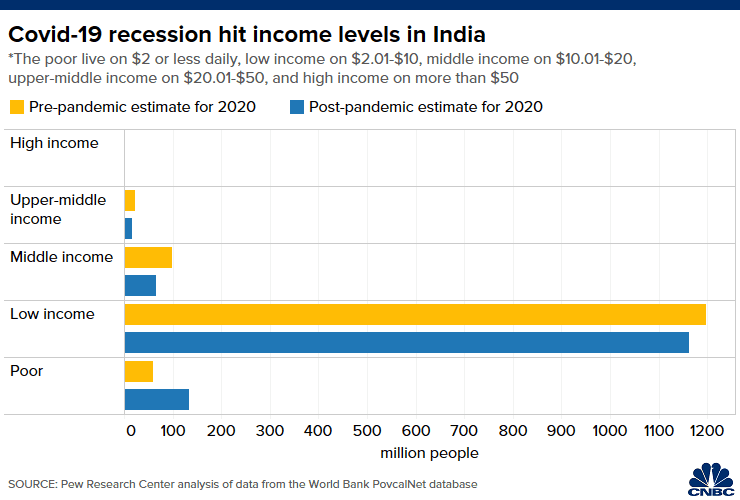
The International Monetary Fund forecast the Indian economy to shrink by 8% in the fiscal year ending this month, before growing by 11.5% in the next fiscal year starting April.
The increase in poverty in India “claws back several years of progress on this front,” Rakesh Kochhar, senior researcher at Pew Research Center, wrote in a report.
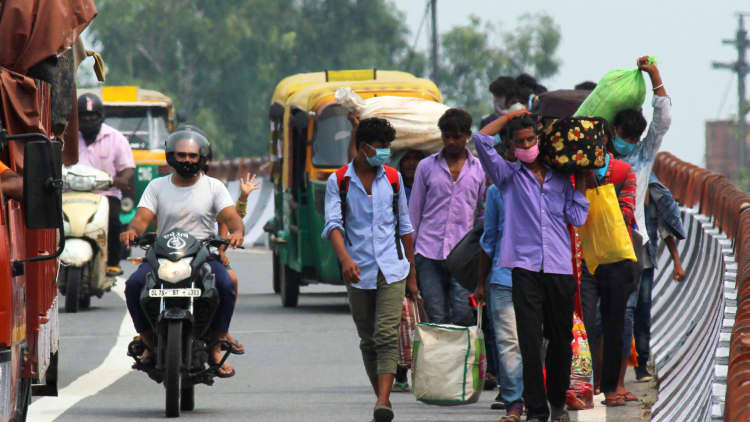
watch now
VIDEO08:51
How to fix rising income inequality during Covid-19
From 2011 to 2019, the number of poor people in India was estimated to have dropped from 340 million to 78 million, he said in the report. That number would have fallen further to 59 million last year without the pandemic, but it is instead projected to rise to 134 million, the analysis showed.
Growth in the country’s middle class also took a hit. Those in the middle-income tier, defined as $10.01 to $20 a day, in India grew from 29 million to 87 million between 2011 and 2019 — and is expected to fall to 66 million in 2020 because of the Covid recession, said Kochhar.
Smaller effect in China
Like India, China has a large population of around 1.4 billion people. But the pandemic’s effect on poverty was much smaller in China, according to Pew Research Center.China’s economy expanded by 2.3% last year and is expected to grow by 8.1% this year, according to the latest IMF forecast. It was the only major economy to grow in 2020 — and that has helped poverty levels to remain “virtually unchanged,” said Kochhar.
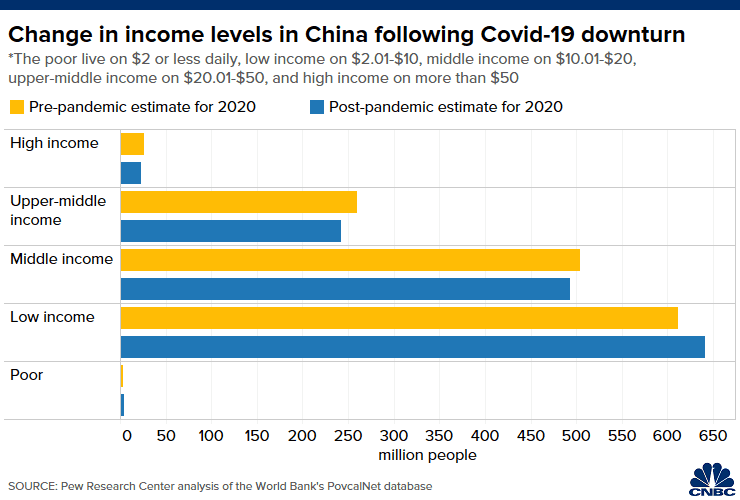
The analysis on India and China accompanied Pew Research Center’s report on the how the Covid-19 outbreak affected income levels around the world.
Globally, an additional 131 million people became poor because of the global recession last year, compared with what it would have been if the pandemic didn’t happen, the research firm said.
“Given that India and China also account for more than a third of the global population, with about 1.4 billion people each, the course of the pandemic in these two countries — and how each recovers — will have a substantial effect on changes in the distribution of income at the global level,” it said.

Covid pandemic pushes 75 million more people into poverty in India, study shows
That number for India accounts for nearly 60% of the global increase in poverty in 2020, an analysis by Pew Research Center showed.
Hahaha, CNN is good enough for me.Hahahahahah
Don’t be angry buddy.
You said it’s according to world bank, right?
Give me the world bank link

Don't angry little Indiot.
CNN quoted World Bank of India being 60% in poverty. I am satisfied.

True, but I am not going to let this bloody stupid Indiot have his way especially when he is wrong. Somebody has to put him in his place.Oh bhai, don't even try, they live in denial, at one time they were using rupees 27 a day for below the poverty line. Not sure what they use now but who cares.
Kuru
SENIOR MEMBER

- Joined
- Jul 8, 2017
- Messages
- 2,880
- Reaction score
- -18
- Country
- Location
Lol Okay but where is world bank data ?Covid pandemic pushes 75 million more people into poverty in India, study shows
Published Fri, Mar 19 20214:03 AM EDT

Yen Nee Lee@YenNee_Lee
Share
Key Points
- The economic recession caused by the Covid-19 pandemic pushed 75 million more people in India into poverty last year, an analysis by Pew Research Center showed.
- That’s compared with the level it would have been without the outbreak, said the research firm.
- That number for India accounts for nearly 60% of the global increase in poverty in 2020, the analysis showed.

Children from a slum in India stand in queue to get free food after the government eased a nationwide Covid-19 lockdown, in New Delhi on June 15, 2020.
Prakash Singh | AFP | Getty Images
Around 75 million more people in India fell into poverty last year because of the pandemic-induced economic recession, compared with what it would have been without the outbreak, an analysis by Pew Research Center showed on Thursday.
That number for India accounts for nearly 60% of the global increase in poverty in 2020, the analysis showed. It defined the poor as people who live on $2 or less daily.
India has experienced one of the largest Covid-19 outbreaks globally. As of Friday, the country has reported a total of 11.51 million infections — trailing only the U.S. and Brazil — and over 159,300 deaths, according to data compiled by Johns Hopkins University.

The International Monetary Fund forecast the Indian economy to shrink by 8% in the fiscal year ending this month, before growing by 11.5% in the next fiscal year starting April.
The increase in poverty in India “claws back several years of progress on this front,” Rakesh Kochhar, senior researcher at Pew Research Center, wrote in a report.

watch now
VIDEO08:51
How to fix rising income inequality during Covid-19
From 2011 to 2019, the number of poor people in India was estimated to have dropped from 340 million to 78 million, he said in the report. That number would have fallen further to 59 million last year without the pandemic, but it is instead projected to rise to 134 million, the analysis showed.
Growth in the country’s middle class also took a hit. Those in the middle-income tier, defined as $10.01 to $20 a day, in India grew from 29 million to 87 million between 2011 and 2019 — and is expected to fall to 66 million in 2020 because of the Covid recession, said Kochhar.
Smaller effect in China
Like India, China has a large population of around 1.4 billion people. But the pandemic’s effect on poverty was much smaller in China, according to Pew Research Center.
China’s economy expanded by 2.3% last year and is expected to grow by 8.1% this year, according to the latest IMF forecast. It was the only major economy to grow in 2020 — and that has helped poverty levels to remain “virtually unchanged,” said Kochhar.

The analysis on India and China accompanied Pew Research Center’s report on the how the Covid-19 outbreak affected income levels around the world.
Globally, an additional 131 million people became poor because of the global recession last year, compared with what it would have been if the pandemic didn’t happen, the research firm said.
“Given that India and China also account for more than a third of the global population, with about 1.4 billion people each, the course of the pandemic in these two countries — and how each recovers — will have a substantial effect on changes in the distribution of income at the global level,” it said.

Covid pandemic pushes 75 million more people into poverty in India, study shows
That number for India accounts for nearly 60% of the global increase in poverty in 2020, an analysis by Pew Research Center showed.www.cnbc.com
Hahaha, CNN is good enough for me.
Don't angry little Indiot.
CNN quoted World Bank of India being 60% in poverty. I am satisfied.
True, but I am not going to let this bloody stupid Indiot have his way especially when he is wrong. Somebody has to put him in his place.
Muji.Iqbal
SENIOR MEMBER

- Joined
- Apr 19, 2023
- Messages
- 2,219
- Reaction score
- -3
- Country
- Location
Yes the Indian definition of poverty is different from Pakistan's definition of poverty.Oh bhai, don't even try, they live in denial, at one time they were using rupees 27 a day for below the poverty line. Not sure what they use now but who cares.
I think the official poverty for Pakistan is 22% poverty. India is 60%.
40% of Pakistan is in poverty if you use Indian definition of poverty.
Fvck off Indiot. CNN is good enough for me.Lol Okay but where is world bank data ?
And don't waste my time. I have better things to do than waste my time with an Indiot such as yourself.
@waz take care of this troll @Kuru , he is dishonest and a liar.
Instead of accepting that India has 60% of population in poverty according to CNN- World Bank, he just keeps beating around the bush.
Kuru
SENIOR MEMBER

- Joined
- Jul 8, 2017
- Messages
- 2,880
- Reaction score
- -18
- Country
- Location
HahahahahahhaaFvck off Indiot. CNN is good enough for me.
But buddy, CNN is referring to world bank data that doesn’t exist

Muji.Iqbal
SENIOR MEMBER

- Joined
- Apr 19, 2023
- Messages
- 2,219
- Reaction score
- -3
- Country
- Location
It does exist you Indiot, maybe that link isn't working. You think a reputable newspaper like CNN would report something wrong you IndiotHahahahahahhaa
But buddy, CNN is referring to world bank data that doesn’t exist

Regardless, CNN quotes World Bank which says India is at 60% in poverty.
Now stop wasting my time before I call the mods to deal with you personally.
I am satisfied with CNN's report, and it is a reliable article.
Hahahaaha yourself you fvcking Indiot.Hahahahahahhaa
But buddy, CNN is referring to world bank data that doesn’t exist

CNN-World Bank says India has 60% in poverty.
 The laugh is on you, not us Pakistanis.
The laugh is on you, not us Pakistanis. 
Kuru
SENIOR MEMBER

- Joined
- Jul 8, 2017
- Messages
- 2,880
- Reaction score
- -18
- Country
- Location
Arre yaar tu naraaz ho gaya.It does exist you Indiot, maybe that link isn't working. You think a reputable newspaper like CNN would report something wrong you Indiot
Regardless, CNN quotes World Bank which says India is at 60% in poverty.
Now stop wasting my time before I call the mods to deal with you personally.
I am satisfied with CNN's report, and it is a reliable article.
Hahahaaha yourself you fvcking Indiot.
CNN-World Bank says India has 60% in poverty. The laugh is on you, not us Pakistanis.
You wanna believe a data that DOESNT EXIST
banvanaxl
FULL MEMBER

- Joined
- Jun 26, 2008
- Messages
- 875
- Reaction score
- -14
- Country
- Location
My take away was ..
Amina a madrasa chaap muslim lady cooks and cleans for Moni Basu a left libtardian Hindu lady.
Neither reflect the reality of Bharat.
Also
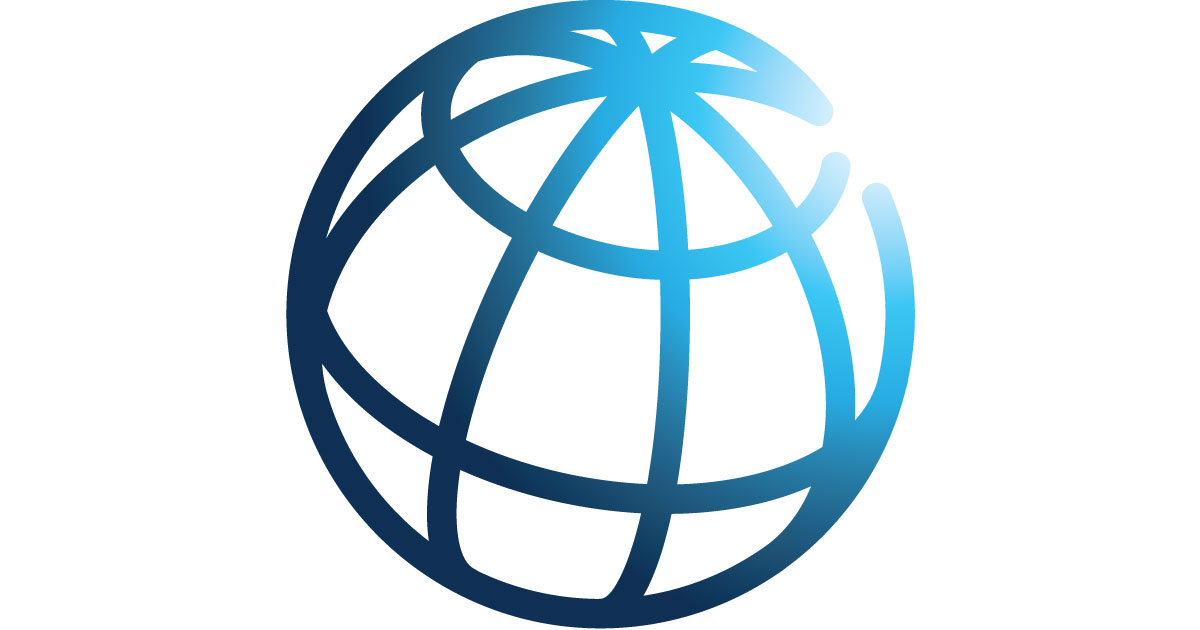
 www.worldbank.org
www.worldbank.org


Amina a madrasa chaap muslim lady cooks and cleans for Moni Basu a left libtardian Hindu lady.
Neither reflect the reality of Bharat.
Also

Overview
Get the latest World Bank data, research and development indicators for India. Access economy facts, statistics, project information, development research from World Bank experts and breaking news.
Last edited:
Muji.Iqbal
SENIOR MEMBER

- Joined
- Apr 19, 2023
- Messages
- 2,219
- Reaction score
- -3
- Country
- Location
No the data does exist you moron, the link to that particular webpage must be broken. CNN is not wrong.Arre yaar tu naraaz ho gaya.
You wanna believe a data that DOESNT EXIST

Go take your Mandir and temple education somewhere. lol.My take away was ..
Amina a madrasa chaap muslim lady cooks and cleans Moni Basu a left libtardian Hindu lady.
Neither reflect the reality of Bharat.
Kuru
SENIOR MEMBER

- Joined
- Jul 8, 2017
- Messages
- 2,880
- Reaction score
- -18
- Country
- Location
Data exists? Where?No the data does exist you moron, the link to that particular webpage must be broken. CNN is not wrong.
Muji.Iqbal
SENIOR MEMBER

- Joined
- Apr 19, 2023
- Messages
- 2,219
- Reaction score
- -3
- Country
- Location
Indiot, CNN is good enough for me. They quoted World Bank, they don't have to show you the actual webpage.Data exists? Where?

Stop barking here.

Sorry Indiot, but poverty in India is 60%. lol. At least Pakistan is not as poor as India. lol.My take away was ..
Amina a madrasa chaap muslim lady cooks and cleans for Moni Basu a left libtardian Hindu lady.
Neither reflect the reality of Bharat.
Also

Overview
Get the latest World Bank data, research and development indicators for India. Access economy facts, statistics, project information, development research from World Bank experts and breaking news.www.worldbank.org
View attachment 956539
View attachment 956538
Idiot, data exists in World Bank, its just that the link is not working right now. But World Bank has officially post it.Data exists? Where?
Stop jumping around.
Muji.Iqbal
SENIOR MEMBER

- Joined
- Apr 19, 2023
- Messages
- 2,219
- Reaction score
- -3
- Country
- Location
Kuru
SENIOR MEMBER

- Joined
- Jul 8, 2017
- Messages
- 2,880
- Reaction score
- -18
- Country
- Location
Indiot, CNN is good enough for me. They quoted World Bank, they don't have to show you the actual webpage.
Stop barking here.
But @banvanaxl posted the correct world bank data buddy
Hahahahhaha
So you mean
You will believe CNN who quoted WB data.
That WB data doesn’t exist.
Now we have the correct WB data, but you don’t want to believe it
LMAO
Muji.Iqbal
SENIOR MEMBER

- Joined
- Apr 19, 2023
- Messages
- 2,219
- Reaction score
- -3
- Country
- Location
Here let me post something here:I posted the data for our the benefit of our pakjeet friend.. he refuses to see it @Kuru
Indians Account for 80% of Those Who Became Poor Globally in 2020 Due to COVID-19: World Bank
In its latest report 'Poverty and Shared Prosperity 2022: Correcting the Course', the World Bank flagged concerns over how the lack of official data on poverty from India affects the world in drawing up global poverty estimates.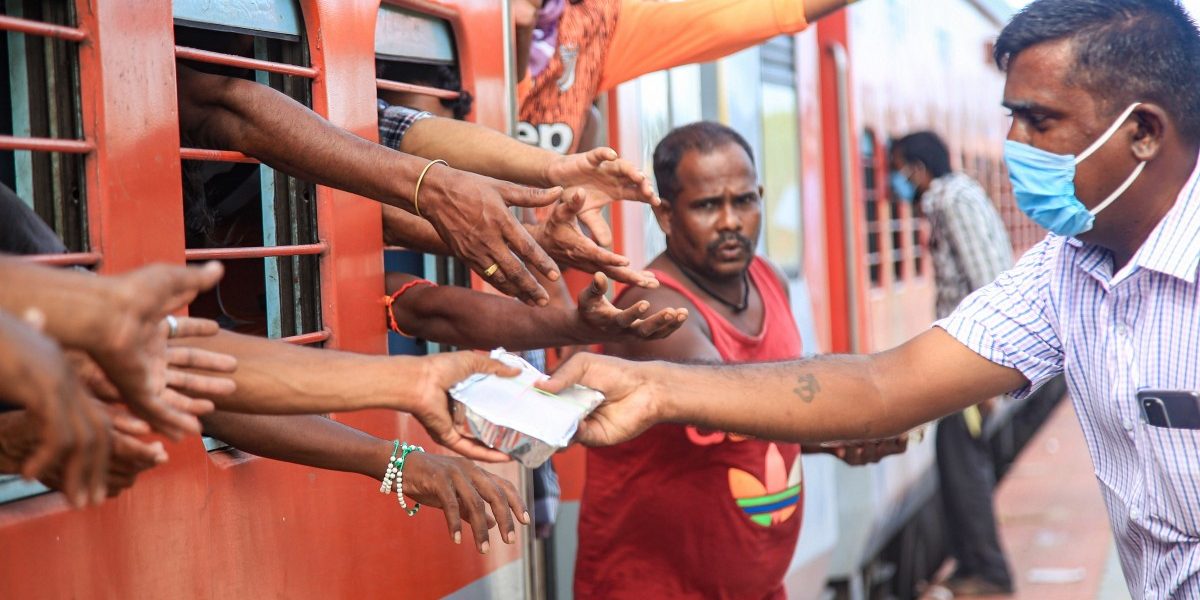
File photo of a volunteer distributing food to migrant workers travelling home at a Kanyakumari railway station. Photo: PTI
Support Us
Listen to this article:
Economy
08/Oct/2022
New Delhi: A study by the World Bank has concluded that nearly 80% of people who slipped into poverty in 2020 due to the COVID-19 pandemic hailed from India. Out of 7 crore people globally who became poor that year due to economic losses caused by the pandemic, Indians accounted for 5.6 crore.

00:00% Buffered
00:00 / 00:00
Copy video url
Play / Pause
Mute / Unmute
Report a problem
Language
Share
Vidverto Player
Globally, extreme poverty levels went up to 9.3% in 2020 compared to 8.4% in 2019, halting the progress made by poverty alleviation programmes worldwide for the first time in decades. In absolute numbers, 7 crore people were additionally pushed into extreme poverty by the end of 2020, increasing the global total of poor to over and above 70 crore.
“The COVID-19 pandemic dealt the biggest setback to global poverty in decades,” the World Bank’s Poverty and Shared Prosperity 2022: Correcting the Course report declared.
Given that India contributes significantly to global poverty levels due to the sheer size of its population, the World Bank flagged that the lack of official data on poverty from India had become a hindrance in drawing up global estimates. Since 2011, the Indian government has stopped publishing data on poverty.
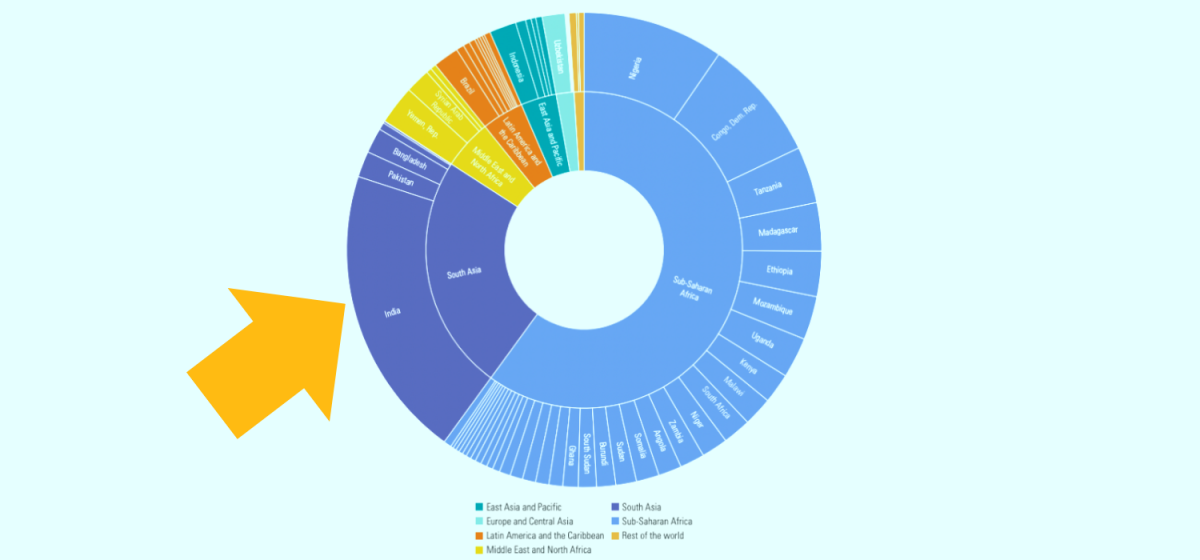
Source: World Bank.
It noted that due to the lack of official data, the World Bank had relied upon the findings of the Centre for Monitoring Indian Economy’s (CMIE’s) Consumer Pyramids Household Survey (CPHS).
Although the findings by the private data firm are yet to be finalised, the World Bank said it had used it for estimating Indian, regional and global poverty levels due to the want of official data. The CPHS data for 2020 noted that 5.6 crore Indians slipped into poverty in 2020.
The report said the World Bank chose to use CHPS data for India over its own paper – published in April 2022 and estimated that 2.3 crore Indians additionally slipped into poverty in 2020 – because poverty in India was “significantly higher” than its own estimates.
Also read: Is it Possible to Make India Poverty-Free by 2047?
The confusion over the data emerging from India, as enunciated by the World Bank report, has once again brought to the fore collective frustration and concern articulated by economists and statisticians in the country and the world over for some time now over Narendra Modi’s government reluctance to release official data, adversely affecting developmental interventions.
The most recent official data on poverty in India dates back to 2011-12 by the National Sample Survey Office of India.
The World Bank report, however, noted that depending upon the method of estimating the number of poor in India rose anywhere between 2.3 crore and 5.6 crore in 2020. “A national accounts-based projection implies an increase of 23 million, whereas initial estimates using the data described in box O.2 [relating to CMIE data] suggest an increase of 56 million — this latter number is used for the global estimate,” the report stressed.
“Because of India’s size, the lack of recent survey data for the country significantly affects the measurement of global poverty, as was evident in Poverty and Shared Prosperity 2020,” the report said.
The World Bank, however, observed that overall poverty in India was on a downward slide – largely due to a reduction in poverty in rural areas – between 2011 and 2020 when the pandemic hit. “Even though overall poverty has declined, it is by less than what earlier estimates used for global poverty measurement would suggest,” the report noted, referring to the 2011-20 period.
Global scenario
Across the world, poverty levels had shown a downward trajectory until the pandemic hit in 2020. The pandemic, however, resulted in a “historically large addition to poverty levels globally”, according to the World Bank report.
Consequently, an additional 70 million people were pushed into extreme poverty by the end of 2020 – taking the extreme poverty levels globally from 8.4% in 2019 to 9.4% by the end of 2020.
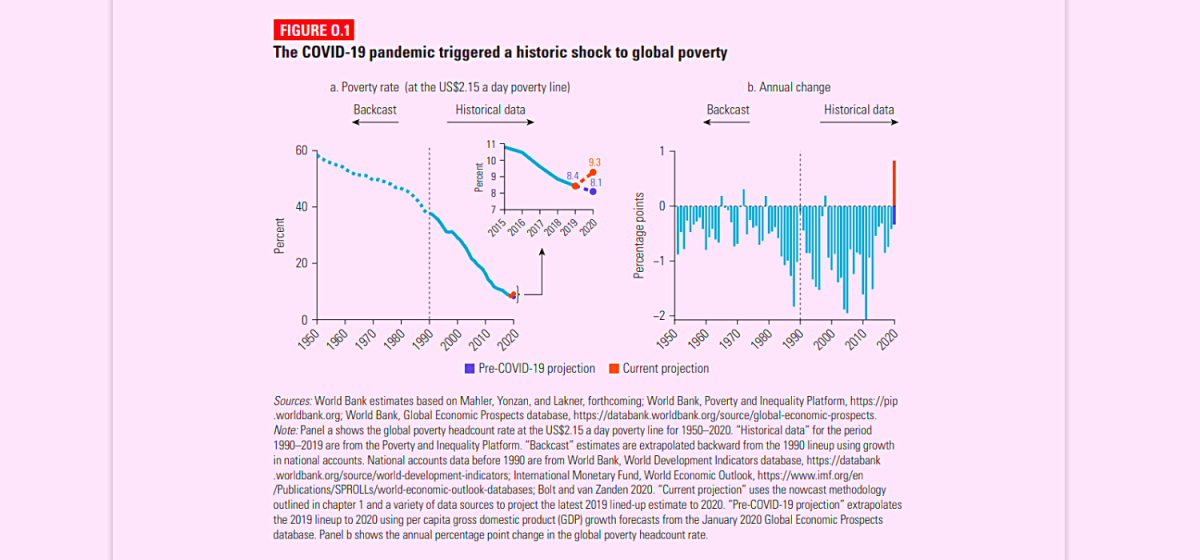
Source: World Bank
“2020 marked a historic turning point – an era of global income convergence gave way to global divergence. The world’s poorest people bore the steepest costs of the pandemic. Incomes in the poorest countries fell much more than incomes in rich countries. As a result, the income losses of the world’s poorest were twice as high as the world’s richest, and global inequality rose for the first time in decades,” the report observed.
It further noted that rising food and energy prices – exacerbated by climate change and ongoing conflict between Russia and Ukraine – have “hindered a swift recovery” even after the world limped back to normalcy in the aftermath of the COVID-19 pandemic.
Coming up with a bleak forecast for the world, the report said, “The world is unlikely to meet the goal of ending extreme poverty by 2030 absent history-defying rates of economic growth over the remainder of this decade.”
Way forward for a better world
The report offers three key priority actions for fiscal policy in the coming years, as the world tries to “course correct”. One, reorienting spending away from subsidies towards support targeted to the poor and vulnerable. Two, increasing public investment to support long-run development. Three, mobilising public revenue without hurting the poor.
However, mindful of the situation on the ground, the report adds a caveat, “Reforming fiscal policy will be an essential element of correcting course, but we must be realistic about how much we can expect it to do. Despite the promise of fiscal reforms, simulations suggest it will take heroic efforts toward more effective fiscal policy choices to restore the pandemic-related losses in the next four to five years. Successful fiscal reform will require the support of sufficiently powerful domestic coalitions interested in pursuing these types of policy goals, as well as stepped-up global cooperation.”

Indians Account for 80% of Those Who Became Poor Globally in 2020 Due to COVID-19: World Bank
In its latest report 'Poverty and Shared Prosperity 2022: Correcting the Course', the World Bank flagged concerns over how the lack of official data on poverty from India affects the world in drawing up global poverty estimates.
@Dalit
India gained more poverty during COVID. lol
Similar threads
- Replies
- 60
- Views
- 3K
- Replies
- 0
- Views
- 816
- Replies
- 0
- Views
- 430
- Replies
- 4
- Views
- 605

